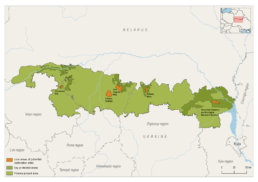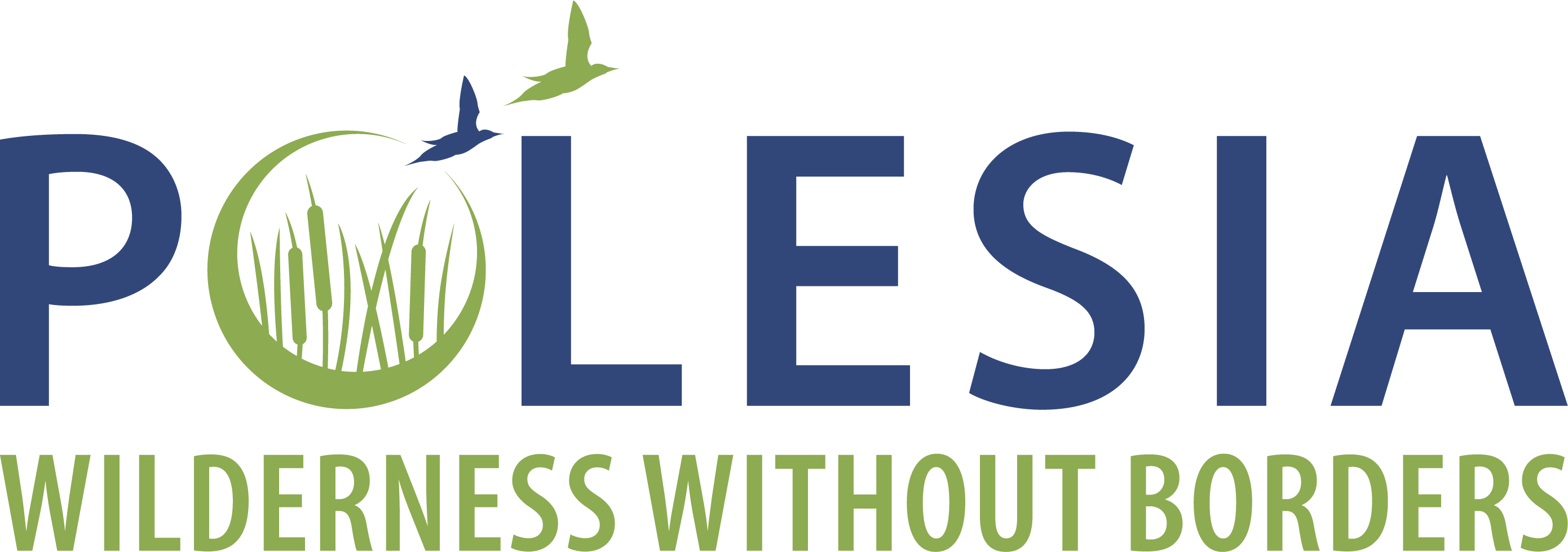Chornobyl Radiation and Ecological Biosphere Reserve
The reserve is an evacuation zone following the Chornobyl nuclear power plant accident (1986), with high levels of radioactive contamination. To the north it borders the Polesie Radioecological Reserve (Belarus), which is also an evacuation zone.
The area has a variety of landscapes and ecosystems typical for Polesia. It includes forests and peat bogs, the Pripyat River valley and many medium and small rivers. Abandoned settlements and former agricultural areas occupy a significant part of the reserve.
Large forest areas are located in the north-western part of the reserve, along the border with Belarus, as well as in the south and north-east of the reserve. The eastern part of the area is crossed by the Pripyat River valley (up to 7 km wide), which is almost completely preserved in its natural state, with numerous meanders and channels. At the south-eastern edge of the biosphere reserve, the Pripyat River joins the Dnieper to form the Kyiv Water Reservoir. The central part includes abandoned, overgrown agricultural land interspersed with small forest massifs.

Country: Ukraine
Area: 226,964.7 ha
National protection status: Biosphere Reserve
International protection status: Emerald Network (UA0000046) - Chornobylskyi Biosphere Reserve (227,381.0 ha); IBA (UA015) - Kyivs'ke reservoir (partly).
1290 species
of vascular plants recorded in the area
25 key habitats
listed in the Resolution #4
of the Standing Committee
to the Bern Convention
>60 species
listed in the Resolution #6 of the Standing Committee to the Bern Convention
Land cover

Forests

Meadows and bogs

Former agricultural lands

Waterbodies

Others
Biodiversity and natural values

Habitats
The area is now in the process of the natural ecosystem restoration after human activity has largely stopped here. The most valuable within the reserve are fragments of natural oak, pine, willow forests, the biotopes of river floodplains, and water complexes of the rivers. The site embraces a diversity of habitats, including 25 ones requiring specific protection under the Resolution No 4 of the Standing Committee to the Bern Convention, the following are among them:
Freshwater Aquatic Habitats
- Floating Plant Communities (3150): Floating frogbit rafts, Floating water-soldier rafts, Floating bladderwort colonies;
- Mesotrophic vegetation of slow-flowing rivers (3260);
Wetlands and Mires
- Transition mires and quaking bogs (7140),
- Beds of large sedges (normally without free-standing water),
- Moist or wet eutrophic and mesotrophic grassland (6440),
- Moist or wet tall-herb and fern fringes and meadows (6430);
Forest and Woodland
- Riverine scrub,
- Riverine willow woodland (91E0),
- Sphagnum birch woods (91D0),
- Acidophilous oak-dominated woodland (9190) – on poorer, acidic soils,
- Oak-ash-hornbeam woodland (9170) – on richer, neutral soils.



Biodiversity
The flora of the biosphere reserve comprises the impressive 1290 vascular plant species. Among them are such rare ones as: the Lilyleaf Ladybells (Adenophora lilifolia), the Waterwheel (Aldrovanda vesiculosa), the Eastern Pasqueflower (Pulsatilla patens), the Lapland Willow (Salix lapponum), the Myrtle-leaved Willow (Salix myrtilloides), the Siberian Iris (Iris sibirica), the Buxbaum’s Sedge (Carex buxbaumii).
The reserve is a vital habitat for a number of species. More than 60 species occurring here are mentioned in the Resolution No 6 of the Standing Committee to the Bern Convention. Over 100 species of animals and plants are listed in the Red Book of Ukraine.

Fauna
The wildlife of the reserve includes 370 vertebrate species: 48 species of fish, 18 – of amphibians and reptiles, 245 species of birds, and 59 species of mammals.
The site is a key habitat for the Tawny Pipit (Anthus campestris), the Short-eared Owl (Asio flammeus), the Bittern (Botaurus stellaris), the Black Tern (Chlidonias niger), the Whiskered Tern (Chlidonias hybridus), the Ortolan Bunting (Emberiza hortulana), the Little Bittern (Ixobrychus minutus), the Little Crake (Porzana parva), the Common Tern (Sterna hirundo), the Barred Warbler (Sylvia nisoria), the Terek Sandpiper (Xenus cinereus), the European Beaver (Castor fiber), the Wolf (Canis lupus), the Common Otter (Lutra lutra), the Desman (Desmana moschata), the European Mink (Mustela lutreola), the Brown Bear (Ursus arctos).
The absence of dykes and the hydrological conditions in river ecosystems make the site a vital spawning ground for many rare fish species, such as the Ukrainian Brook lamprey (Eudontomyzon mariae), the Asp (Aspius aspius), the SpinedLoach (Cobitis taenia), the White-finned Gudgeon (Gobio albipinnatus), the Balon’s Ruffe (Gymnocephalus baloni), the Ziege (Pelecus cultratus), the Lake Minnow (Phoxinus percnurus), the European Bitterling (Rhodeus sericeus amarus), the Golden Loach (Sabanejewia aurata) аs well as of reptiles and amphibians: the European Pond Turtle (Emys orbicularis), the Crested Newt (Triturus cristatus), the Fire-bellied Toad (Bombina bombina).
The large area and almost total absence of people are the important conditions for conservation of large European mammals, including the re-established population of the European Bison (Bison bonasus), the Wolf (Canis lupus), the Eurasian Lynx (Lynx lynx), and the Brown Bear (Ursus arctos).


The most important impacts and threats

Radioactive contamination

Clear-cut logging, deadwood removal

Old drainage systems

Wildfires
Protection and conservation needs
Zoning has been established for the entire biosphere reserve. About 31.5% of its area is the strict protection zone, 19.8% – the zone of regulated protected regime. Restrictions on economic activity are set for the entire reserve. Visiting the site without a special permission is prohibited. A management plan has been developed for the biosphere reserve. Among the recommended additional conservation measures are compilation fo a detailed inventory of the conservation values, as well as handing them over under the land-users’ protection.



The project “Polesia – Wilderness Without Borders” is part of the Endangered Landscapes & Seascapes Programme and is funded by Arcadia. The project is coordinated by Frankfurt Zoological Society (FZS).

